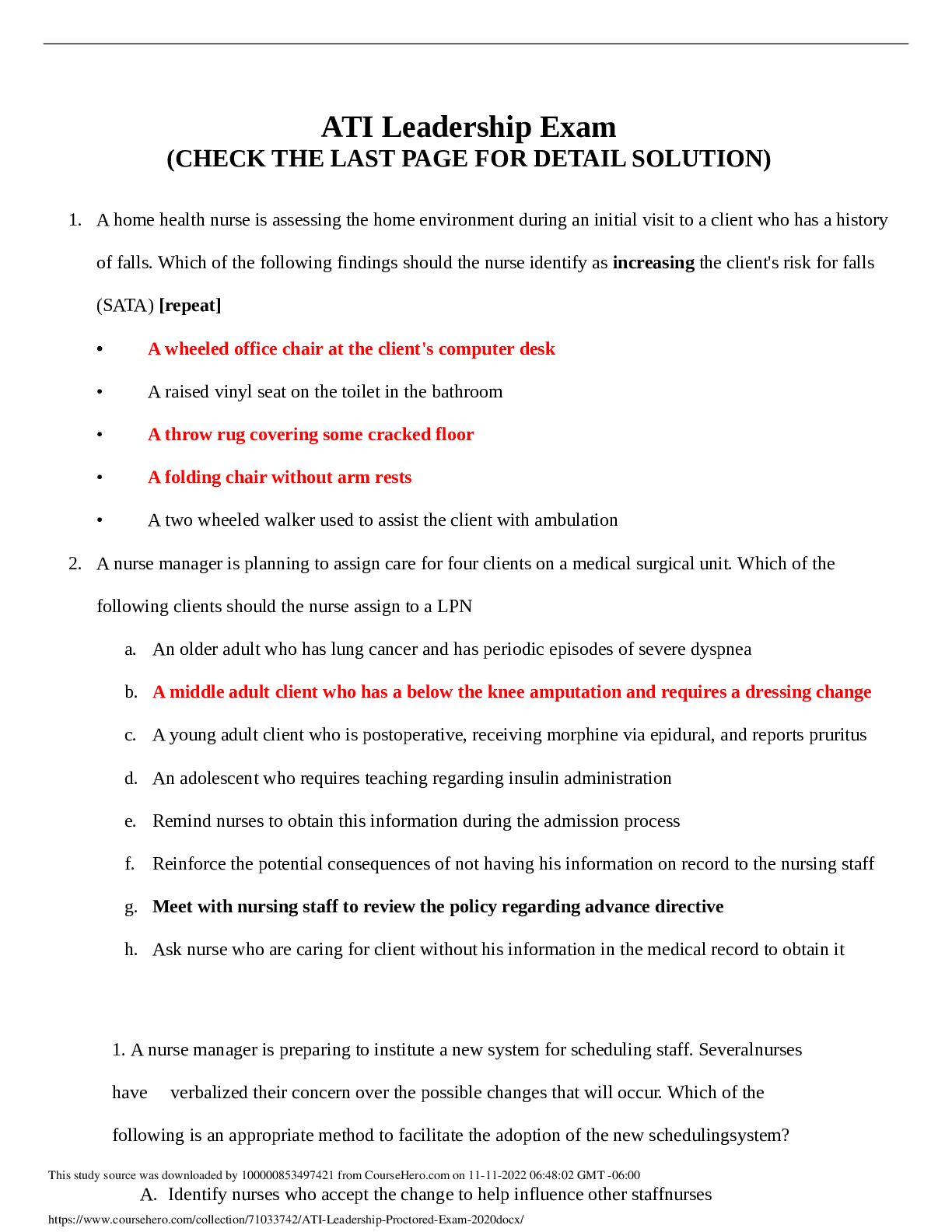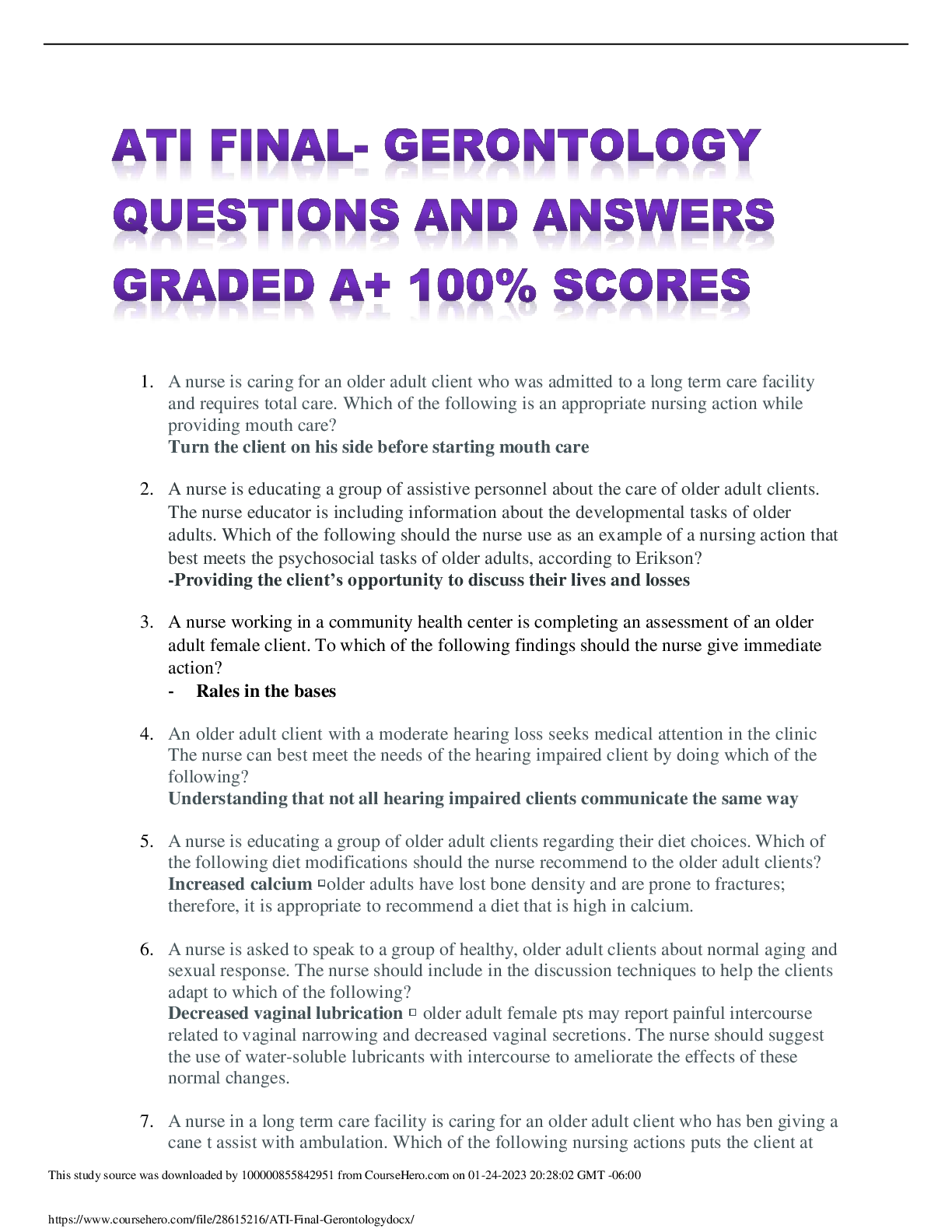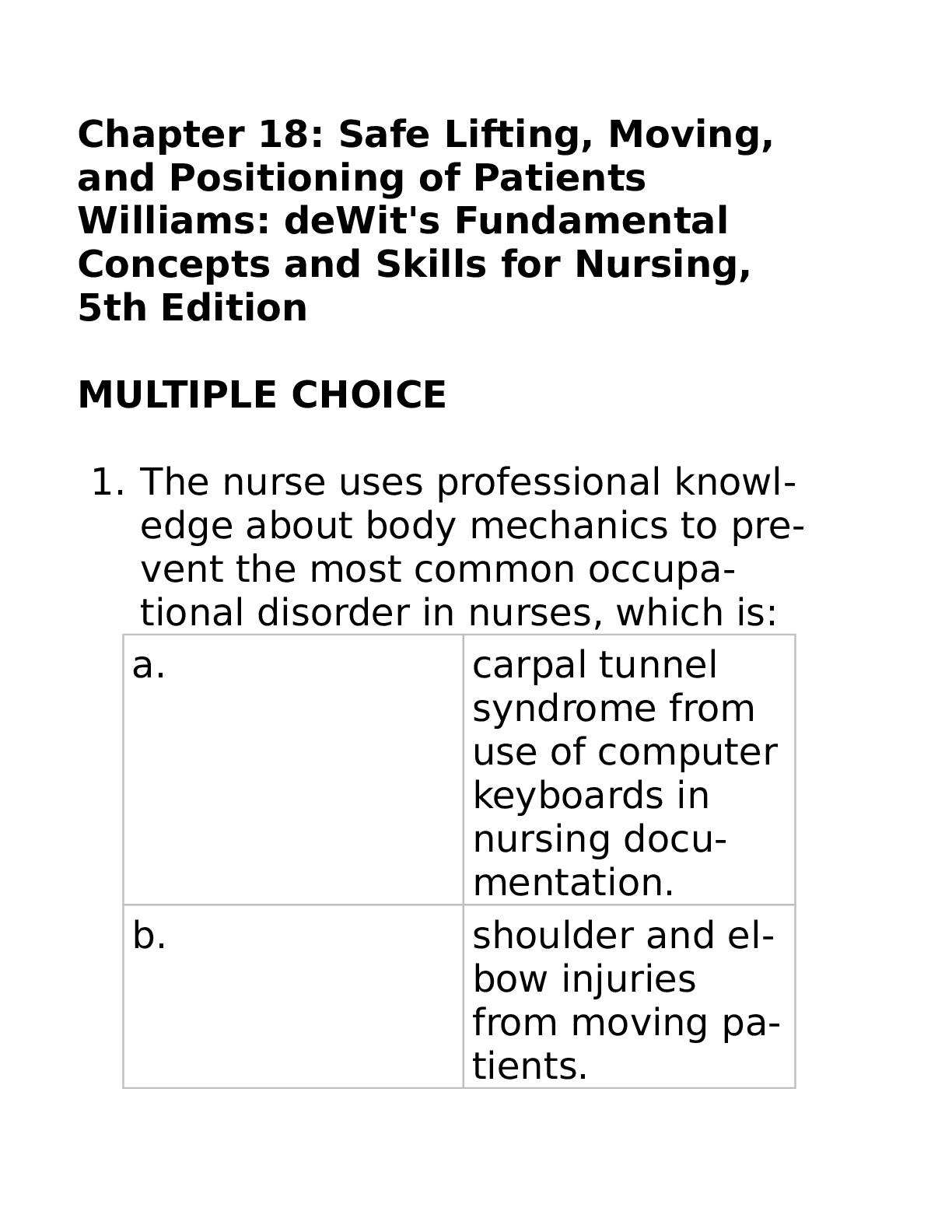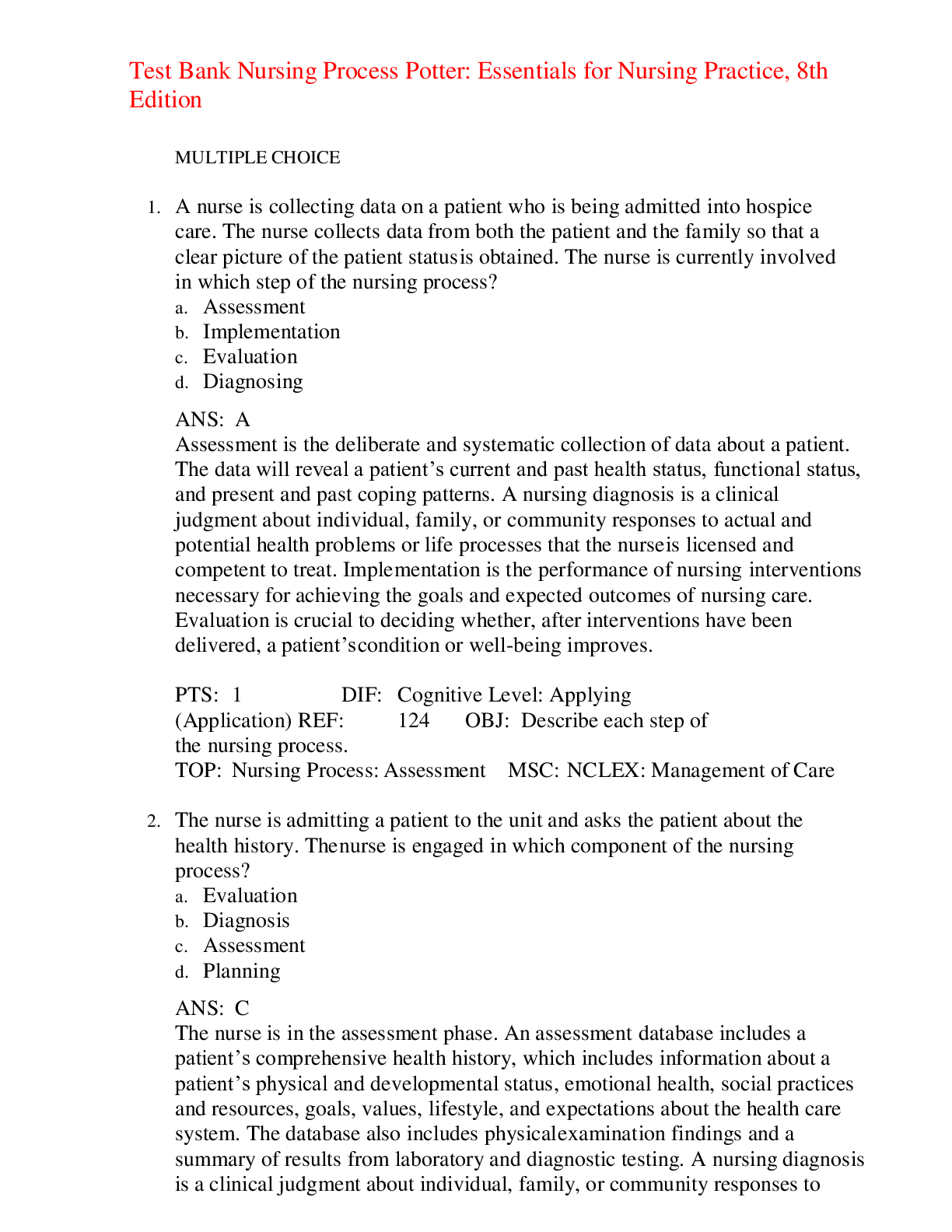*NURSING > EXAM PROCTORED > Chapter 14: Nervous System Alterations Sole: Introduction to Critical Care Nursing, 7th Edition (All)
Chapter 14: Nervous System Alterations Sole: Introduction to Critical Care Nursing, 7th Edition
Document Content and Description Below
Chapter 14: Nervous System Alterations Sole: Introduction to Critical Care Nursing, 7th Edition MULTIPLE CHOICE 1. The nurse admits a patient to the critical care unit following a motorcycle crash.... Assessment findings by the nurse include blood pressure 100/50 mm Hg, heart rate 58 beats/min, respiratory rate 30 breaths/min, and temperature of 100.5°F. The patient is lethargic, responds to voice but falls asleep readily when not stimulated. Which nursing action is most important to include in this patient’s plan of care? a. Frequent neurological assessments b. Side to side position changes c. Range-of-motion to extremities d. Frequent oropharyngeal suctioning ANS: A Nurses complete neurological assessments based on prescribed frequency and the severity of the patient’s condition. The newly admitted patient has an altered neurological status, so frequent neurological assessments are most important to include in the patient’s plan of care. Side to side position changes, range-of-motion exercises, and frequent oral suctioning are nursing actions that may need to be a part of the patient’s plan of care, but in the setting of increased intracranial pressure they should not be regularly performed unless indicated. DIF: Cognitive Level: Apply/Application REF: p. 350 OBJ: Describe the nursing and medical management of patients with increased intracranial pressure. TOP: Nursing Process Step: Planning MSC: NCLEX Client Needs Category: Physiological Integrity 2. A patient with a head injury has an intracranial pressure (ICP) of 18 mm Hg. The blood pressure is 144/90 mm Hg, and mean arterial pressure (MAP) is 108 mm Hg. What is the cerebral perfusion pressure (CPP)? a. 54 mm Hg b. 72 mm Hg c. 90 mm Hg d. 126 mm Hg ANS: C CPP = MAP – ICP. In this case, CPP = 108 mm Hg – 18 mm Hg = 90 mm Hg. All other calculated responses are incorrect. DIF: Cognitive Level: Apply/Application REF: p. 354 OBJ: Complete an assessment on a critically ill patient with nervous system injury. TOP: Nursing Process Step: Assessment MSC: NCLEX Client Needs Category: Physiological Integrity 3. While caring for a patient with a traumatic brain injury, the nurse assesses an ICP of 20 mm Hg and a CPP of 85 mm Hg. What is the best interpretation by the nurse? a. Both pressures are high. b. Both pressures are low. c. ICP is high; CPP is normal. d. ICP is high; CPP is low. ANS: C The ICP is above the normal level of 0 to 15 mm Hg. The CPP is within the normal range. All other listed responses are incorrect. DIF: Cognitive Level: Understand/Comprehension REF: p. 354 OBJ: Complete an assessment on a critically ill patient with nervous system injury. TOP: Nursing Process Step: Assessment MSC: NCLEX Client Needs Category: Physiological Integrity 4. The nurse is caring for a mechanically ventilated patient with a sustained ICP of 18 mm Hg. The nurse needs to perform an hourly neurological assessment, suction the endotracheal tube, perform oral hygiene care, and reposition the patient to the left side. What is the best action by the nurse? a. Hyperoxygenate during endotracheal suctioning. b. Elevate the patient’s head of the bed 30 degrees. c. Apply bilateral heel protectors after repositioning. d. Provide rest periods between nursing interventions. ANS: D Sustained increases in ICP lasting longer than 5 minutes should be avoided. This is accomplished by spacing nursing care activities to allow for rest between activities. All other nursing actions are a part of the patient’s plan of care; however, spacing out interventions is the priority. DIF: Cognitive Level: Apply/Application REF: p. 361 OBJ: Describe the nursing and medical management of patients with increased intracranial pressure. TOP: Nursing Process Step: Intervention MSC: NCLEX Client Needs Category: Physiological Integrity 5. While caring for a patient with a basilar skull fracture, the nurse assesses clear drainage from the patient’s left naris. What is the best nursing action? a. Have the patient blow the nose until clear. b. Insert bilateral cotton nasal packing. c. Place a nasal drip pad under the nose. d. Suction the left nares until the drainage clears. ANS: C In the presence of suspected cerebrospinal fluid leak, drainage should be unobstructed and free flowing. Small bandages may be applied to allow for fluid collection and assessment. Patients should be instructed not to blow their nose because that action may further aggravate the dural tear. Suction catheters should be inserted through the mouth rather than the nose to avoid penetrating the brain due to the dural tear. DIF: Cognitive Level: Apply/Application REF: p. 368 OBJ: Describe the nursing and medical management of patients with skull fractures. TOP: Nursing Process Step: Intervention MSC: NCLEX Client Needs Category: Physiological Integrity [Show More]
Last updated: 2 years ago
Preview 1 out of 16 pages
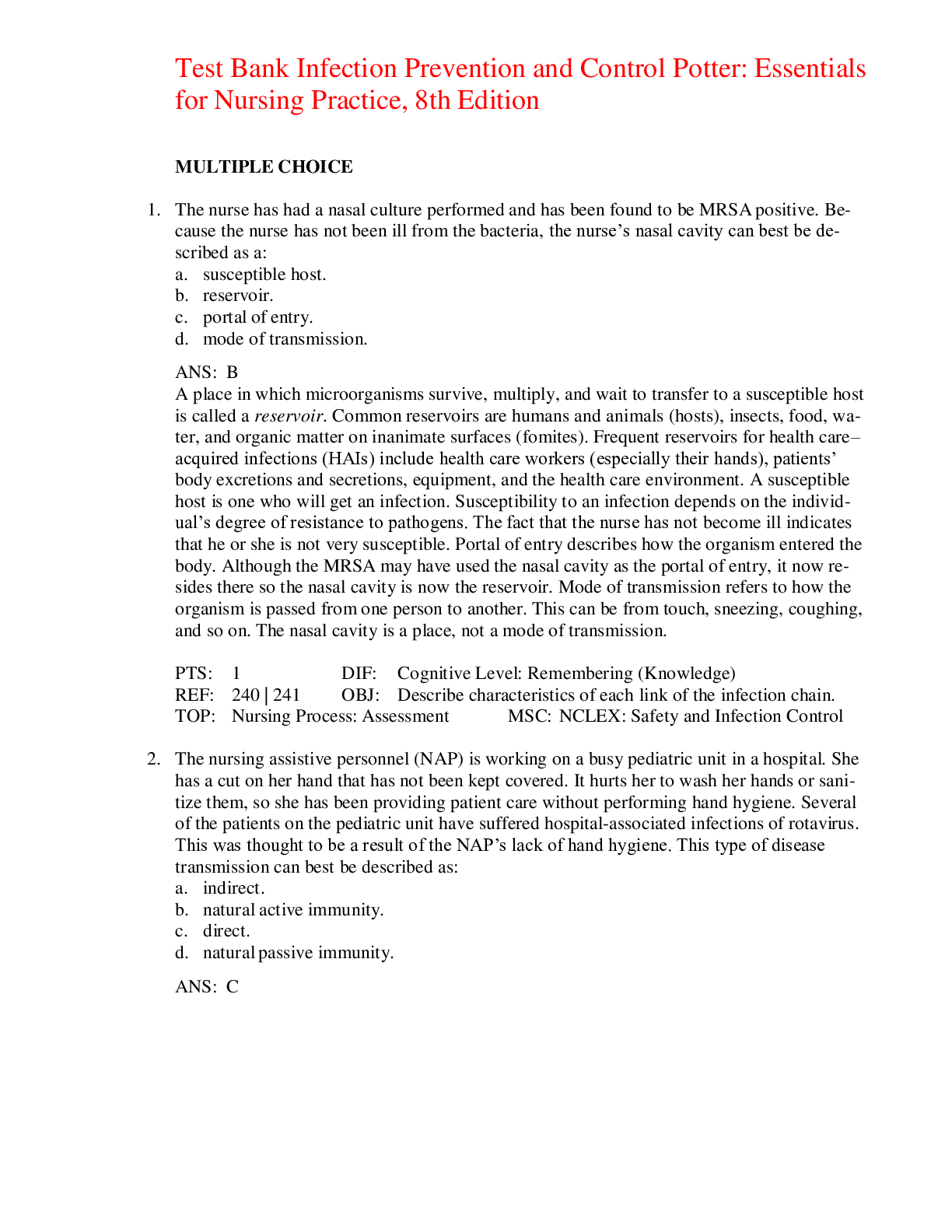
Buy this document to get the full access instantly
Instant Download Access after purchase
Buy NowInstant download
We Accept:

Reviews( 0 )
$9.00
Can't find what you want? Try our AI powered Search
Document information
Connected school, study & course
About the document
Uploaded On
Jun 03, 2021
Number of pages
16
Written in
Additional information
This document has been written for:
Uploaded
Jun 03, 2021
Downloads
0
Views
54


.png)


